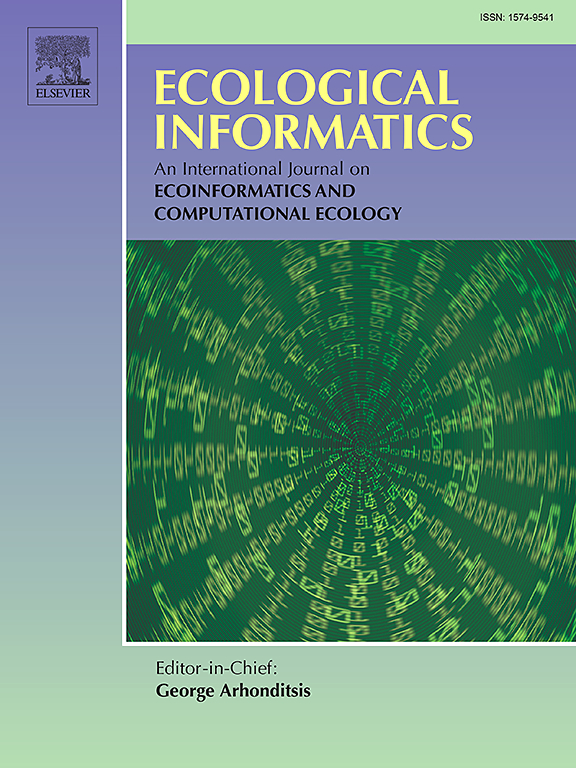首个使用轻量级联想记忆Hopfield神经网络的生物声学检测人工智能模型
IF 7.3
2区 环境科学与生态学
Q1 ECOLOGY
引用次数: 0
摘要
在保护生物声学中,一个日益增长的问题是分析被动声学监测设备产生的大量数据的艰巨任务。在本文中,我们提出了一个替代的人工智能模型,它有可能帮助缓解这个问题。我们的模型公式解决了使用当前人工智能模型进行生物声学分析时遇到的关键问题,即:可用的训练数据有限;培训和实施这些模式对环境的影响,特别是在能源消耗和碳足迹方面;以及相关的硬件要求。在这项工作中开发的模型通过透明和可解释的Hopfield神经网络使用联想记忆来存储信号并检测类似的信号,然后可以用来对物种进行分类。训练是快速的(3毫秒),因为数据集中每个目标声音只需要一个代表性信号。该模型速度很快,在标准的苹果MacBook Air上,只需要5.4秒就可以预处理并分类所有10384个公开的蝙蝠录音。该模型也是轻量级的,即内存占用很小,只有144.09 MB的RAM使用。因此,低计算需求使该模型非常适合用于各种标准个人设备,并有可能通过边缘处理设备在现场部署。它也具有竞争力的准确性,用于评估模型的标记数据集的精度高达86%。事实上,通过专家实地指导,我们找不到一个模型和人工识别不一致的案例。虽然选择了蝙蝠回声定位呼叫的数据集来演示这种首创的人工智能模型,但该模型仅接受了两种具有代表性的回声定位呼叫的训练,但该模型并非特定于物种。总之,我们提出了一个公平的人工智能模型,它有可能成为快速、轻量级、可持续、透明、可解释和准确的生物声学分析的游戏规则改变者。本文章由计算机程序翻译,如有差异,请以英文原文为准。
First-of-its-kind AI model for bioacoustic detection using a lightweight associative memory Hopfield neural network
A growing issue within conservation bioacoustics is the laborious task of analysing the vast amount of data generated from the use of passive acoustic monitoring devices. In this paper, we present an alternative AI model which has the potential to help alleviate this problem. Our model formulation addresses the key issues encountered when using current AI models for bioacoustic analysis, namely: the limited training data available; the environmental impact, particularly in energy consumption and carbon footprint of training and implementing these models; and the associated hardware requirements. The model developed in this work uses associative memory via a transparent and explainable Hopfield neural network to store signals and detect similar signals which can then be used to classify species. Training is rapid (3 milliseconds), as only one representative signal is required for each target sound within a dataset. The model is fast, taking only 5.4 seconds to pre-process and classify all 10384 publicly available bat recordings, on a standard Apple MacBook Air. The model is also lightweight, i.e., has a small memory footprint of 144.09 MB of RAM usage. Hence, the low computational demands make the model ideal for use on a variety of standard personal devices with potential for deployment in the field via edge-processing devices. It is also competitively accurate, with up to 86% precision on the labelled dataset used to evaluate the model. In fact, we could not find a single case of disagreement between model and manual identification via expert field guides. Although a dataset of bat echolocation calls was chosen to demonstrate this first-of-its-kind AI model, trained on only two representative echolocation calls, the model is not species specific. In conclusion, we propose an equitable AI model that has the potential to be a game changer for fast, lightweight, sustainable, transparent, explainable and accurate bioacoustic analysis.
求助全文
通过发布文献求助,成功后即可免费获取论文全文。
去求助
来源期刊

Ecological Informatics
环境科学-生态学
CiteScore
8.30
自引率
11.80%
发文量
346
审稿时长
46 days
期刊介绍:
The journal Ecological Informatics is devoted to the publication of high quality, peer-reviewed articles on all aspects of computational ecology, data science and biogeography. The scope of the journal takes into account the data-intensive nature of ecology, the growing capacity of information technology to access, harness and leverage complex data as well as the critical need for informing sustainable management in view of global environmental and climate change.
The nature of the journal is interdisciplinary at the crossover between ecology and informatics. It focuses on novel concepts and techniques for image- and genome-based monitoring and interpretation, sensor- and multimedia-based data acquisition, internet-based data archiving and sharing, data assimilation, modelling and prediction of ecological data.
 求助内容:
求助内容: 应助结果提醒方式:
应助结果提醒方式:


